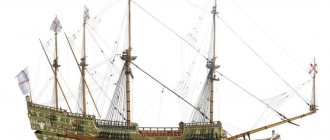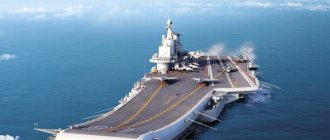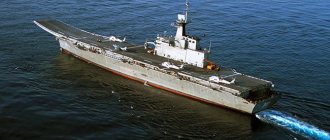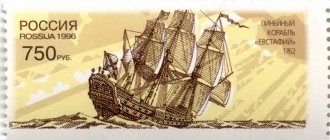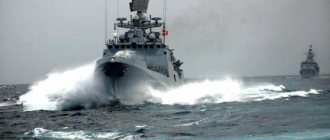Fleet development is a priority task of the Ministry of Defense for the period until 2025. During this period, new ships of the Russian Navy should arrive at all fleet bases.
The Navy is an integral component of the Russian armed forces. It ensures the protection of the country's maritime borders, the suppression of the enemy in international waters and the provision of merchant shipping in the zone of economic responsibility of Russia.
300 years
ago the formation and development of the Russian Navy began
The formation and development of the fleet began 300 years ago under Peter the Great. The Russian Navy is the second in terms of combat power and total tonnage in the world.
Prospects for projects of new ships of the Russian Navy
The state armament program, adopted in 2011, envisaged the rearmament of the main forces of the navy by 2022 and the transfer of equipment to the status of modern models.
See also the article Promising and latest weapons of Russia
The share of new Russian ships by 2022 should be 70%. The quantitative composition of the fleet is annually replenished with new types of combat and auxiliary ships of modifications of the ocean and sea zones.
Organizationally, the Russian fleet includes 4 fleets and one flotilla.
Which are part of the military districts. This specific feature of the Russian fleet has developed due to the size of the territory and the length of the sea borders.
In every critical sector, fleets need to have modern ships of the Russian Navy, including submarines. This entails the cost of financing individual groups and the impossibility of quickly forming a large flotilla, which will include modern Russian warships.
The newest ships of Russia. Icebreaker of project 23550
The rearmament program until 2022 plans for each fleet to be strengthened in a certain part according to its tasks and territorial affiliation. Each of the fleets has its own specifics and solves problems in connection with its location.
New Russian warships are on combat duty in the world's oceans in order to ensure the security of the Motherland from possible attacks from the United States and NATO.
Pacific Fleet
Solve tasks for combat duty and protection of maritime borders in the Pacific Ocean in the Far East.
The Pacific is the most geographically remote fleet.
The main base is Vladivostok. New Russian warships of ranks 1 and 2, as well as submarines, including those with a nuclear power plant, are in service. The current capabilities of the fleet are limited to the near-ocean operating zone, and the quantitative composition has reached a historical minimum.
The combined power is inferior to the fleets of Japan and China, and the waiting time for support from the rest of the Russian fleets will be from 2 to 5 weeks.
Given the remoteness and autonomy of the fleet, the rearmament program pays special attention to the rearmament of the Pacific Fleet. Corvettes, anti-submarine ships and nuclear-powered submarines of the strategic and multi-purpose classes will be put into operation in order to equalize the combat potential of the fleet with the rest of the navies of the countries of the Asian region.
Baltic Fleet
The Baltic Fleet is compact in size and is based in St. Petersburg and Kaliningrad. Performs tasks to protect the maritime border and coastal facilities in the Baltic Sea, as well as potential counteraction to NATO fleets in this region.
The Baltic is the most modest fleet of the Russian Federation in terms of combat potential.
Since it is not armed with strategic and multi-purpose nuclear submarines and large ships with a tonnage of more than 6 thousand tons.
Black Sea Fleet
Over the past three years, the Black Sea Fleet has received reinforcements in the form of ships of the Ukrainian Navy and new Russian warships, which have been commissioned recently. The fleet grouping is reinforced with diesel submarines and missile boats. The fleet carries out the tasks of protecting maritime borders in the Black and Mediterranean seas.
Northern Fleet
The Northern Fleet is the most powerful among the entire Navy. The fleet has a fleet of nuclear-powered submarines that carry nuclear warheads and long-range cruise missiles.
Financing the development of the navy is not limited to the creation and design of new types of ships.
Trillion
rubles is aimed at modernizing shipyards and existing warships.
The potential inherited by the Russian fleet from its Soviet predecessor is enormous, heavy ships of the first rank can be modernized and returned to service, and the service life of the remaining ships with sufficient funding increases by 30-50%.
By the beginning of the fleet rearmament program, the naval forces had declined in numbers and combat capabilities. For operations in the distant ocean there was no possibility of forming a battle group of ships. Thus, the fleet lost the opportunity to solve combat missions beyond the far reaches of the sea.
Small patrol ship (corvette)
The rearmament program provides for placing 50 warships of different classes and ranks on combat duty. Implementation is proceeding according to schedule with the introduction of new ships and modernization of the Soviet heritage.
Not Mistral, but much cooler
Russian Project 23900 UDCs will be superior to the French Mistrals in almost all characteristics. Their displacement will be 25,000 tons, length - about 220 meters, width - up to 33 meters. They will be able to take on board up to 1,000 marines and up to 75 pieces of equipment. The UDC aviation group will consist of more than 20 Ka-29 landing helicopters, Ka-27 anti-submarine helicopters or Ka-52K attack helicopters. To deliver troops, in addition to landing helicopters, the ship’s docking chamber will accommodate up to 6 landing boats of Project 11770 “Serna” or Project 02510.
The lead ship of the project was named “Ivan Rogov” - in honor of Colonel General of the Coastal Service Ivan Vasilyevich Rogov, who during the Great Patriotic War was a member of the Military Council of the Black Sea Fleet and participated in the development of a plan for the liberation of Crimea from the Nazi invaders.
The second ship of Project 23900 - "Mitrofan Moskalenko" - is named after Colonel General of the Coastal Service Mitrofan Ivanovich Moskalenko , who during the Great Patriotic War participated in the development of plans for food supplies to Leningrad by water.
Live firing with the "Dagger" in the Pacific Ocean. Video of exercises of Russian Navy ships Read more
The newest ships of the Russian Navy
Modernization and expansion of the capabilities of the navy involves the supply of not only warships, but also support vessels. The transport forces will be replenished with ships with a tonnage of 6 to 20 thousand tons. Below we describe which warships are currently being built in Russia and will soon leave the stocks.
Project "Ivan Gren"
New ships of the Ivan Gren class have been developed and are being built for the Russian Navy, which should update and mark a new look for the transport component of the navy. The naval forces will acquire 30 transport-class ships and 30 minesweepers.
Large landing ship of project 11711 (Ivan Gren type)
Project "Burevestnik"
The priority of modernization and production of Russia's newest ships in the far sea zone is aimed at the construction of frigates of the Burevestnik project. These ships are equipped with missiles and artillery weapons, which are designed to replace outdated Soviet-made models and add power to the Russian fleet in operations beyond the state's maritime borders.
Project 11356 ships: the proud “Burevestnik” guarding the Motherland
Project "Admiral Essen"
Until the end of the rearmament program, the fleet will receive 7 new ships of this type. They will be distributed among fleets according to needs. Russia's newest warship, the frigate Admiral Essen, was also built.
It has equipment equal to a destroyer and is designed for patrolling and combat operations within the far sea zone. The shipyards are building 3 more of the newest Russian ships of Project 22350.
See also the article Russian Navy and its history
Frigate "Admiral Essen"
See also the article Air cruiser Admiral Kuznetsov: drawing and its technical characteristics
Project "Leader"
New projects for the implementation and replacement of existing destroyer-class ships will be vessels of the Leader project. These ships are equipped with active air defense systems, missile weapons (including cruise missiles) and artillery weapons. The ships' displacement will be 17.5 thousand tons.
A concept is being developed for building and equipping the fleet with attack aircraft carriers with a nuclear power plant. Presumably the total displacement of the project will be 100 thousand tons. As weapons, the ships will be equipped with 2 squadrons and missile weapons using air defense systems.
Draft design of the new generation destroyer "Leader"
Project "Borey"
Attention is paid to the development of the submarine fleet. The shipyards house 5 multi-purpose and strategic submarines of the Borei class. By the end of 2022, the fleet should receive a total of 8 submarines capable of carrying nuclear weapons and cruise missiles. The new boats are also equipped with a new type of hypersonic torpedoes.
Project 955 Borei submarines
Project "Varshavyanka"
Further production is expected for diesel submarines of the Varshavyanka project, which should be available to the Black Sea and Baltic fleets. These submarines are equipped with Caliber cruise missiles capable of destroying enemy targets at a distance of up to 3 thousand kilometers.
Submarines of project 636 "Varshavyanka"
Patrol ship "Vasily Bykov"
The development of small patrol and patrol modern warships of Russia is a priority task for the departments of the country's Ministry of Defense. It is not advisable to release large vessels after border violators and requires preparatory work, while protecting the borders of the homeland requires efficiency.
Soviet models of patrol ships are outdated, their service life has expired, so the fleet urgently needs new designs of Russian warships.
Project 22160 ships became such a replacement.
The ships have the following characteristics:
- the maximum displacement is 1300 tons - this is a small class of ships that does not require complex technical support and the presence of large maintenance personnel. Also, such a displacement makes it possible to produce ships in mass quantities;
- the maximum speed is 30 knots, which is enough to complete assigned tasks and protect maritime borders in a 200-mile economic zone;
- The ship's autonomous operating range is 6 thousand nautical miles. This distance allows one ship to control an area of 1000 kilometers of maritime border;
- vessel crew - 80 people;
- the armament includes artillery weapons, and the main feature is the installation of launch silos for Caliber cruise missiles. This means that a small-sized vessel is capable of causing irreparable damage to ships of the frigate, destroyer class and other ships. There is also the possibility of targeted destruction of enemy ground targets.
Until 2022, the armament program provides for the construction and commissioning of 7 ships of this type into the fleet.
The newest Russian warship "Vasily Bykov" project 22160
Landing helicopter dock ship "Mistral"
During the period of improving relations between France and Russia in 2008, an agreement was reached on the supply of large helicopter carriers of the Mistral project.
The newest Russian warships of this project are designed to operate in the far sea zone as part of an aircraft carrier group and support ground forces through the operation of combat helicopters.
The contract value was $1.2 billion.
However, with the introduction of sanctions, France froze the supply of ships to Russia and paid the amount of fines and penalties. The ships were subsequently transferred to Egypt.
The helicopter carrier has the following characteristics:
- maximum displacement 32 thousand tons;
- ship crew 160 people;
- the armament is represented by detection radar stations, artillery systems, anti-aircraft artillery, missile launch silos and an aviation group designed for 16 attack helicopters.
After the delivery of two ships to Egypt, this country had to purchase sets of attack helicopters from Russia, since the ship designs were “tailored” for Russian weapons.
Mistral-class helicopter docking ship
Promising aircraft carrier according to the project of the KGSC IMDS-2013
Equipping the fleet with aircraft carriers is a priority for management. The aircraft-carrying cruiser currently in service does not meet modern requirements for armament and load in the form of carrier-based aircraft.
See also the article Heavy nuclear-powered missile cruiser "Peter the Great"
Therefore, active development and design of new types of heavy aircraft-carrying ships equipped with a nuclear power plant are underway. The priority is the new cruiser for the Russian Navy of the Storm project, the delivery of which to the fleet has not been determined. The project has the following characteristics:
- The ship's displacement is 100 thousand tons. The aircraft carrier will become a large ship in the navy;
- maintenance crew will be 5,000 people;
- maximum speed - 30 knots;
- the armament will be 90 aircraft in the form of attack carrier-based aircraft and helicopters;
- The range is unlimited thanks to the nuclear engine.
The implementation of the project involves the construction of an aircraft carrier by 2035.
Aircraft carrier designed by KGSC IMDS-2013
Promising destroyer "Leader"
Project 23560 destroyers are designed to replace outdated Soviet models and strengthen the fleet's far sea zone grouping. By 2025, the state plans to build up to 20 new Russian warships of this class, equipped with a full range of weapons.
The new Russian ship has the following characteristics:
- the voyage duration will be up to 90 days of autonomous sailing, and the range will be up to 8,000 nautical miles;
- maximum speed is 32 knots, crew consists of 300 people;
- The ammunition includes the Armat artillery systems, Pantsir anti-aircraft systems, strike weapons of Zircon missiles and a multi-purpose group of helicopters.
See also the article New Russian Zircon rocket - 3M22 and its characteristics
Destroyer "Leader"
Project 11356R patrol ships for the far sea zone
Project 11356 patrol ships are a continuation of the Burevestnik project and further improvement of ships in the far sea zone. Unlike other promising types of weapons, these ships are being successfully put into operation - 3 are in service, 3 are being built at shipyards.
See also the article Project 11356 patrol frigates and their history
The project has weapons comparable to destroyers and the following characteristics:
- displacement is 4 thousand tons;
- the maximum speed reaches 30 knots, the maximum operation in autonomous conditions is 30 days;
- crew - 180 people;
- weapons - Caliber missiles - 8 units, anti-aircraft artillery and anti-submarine weapons systems.
VTS "BASTION"
In a short time
The developer of Project 12700 is the Almaz Central Marine Design Bureau, located in St. Petersburg. Minesweepers are also being built in the Northern capital of Russia at the Sredne-Nevsky shipyard - the only enterprise in the world where they create monolithic hulls up to 80 m long.
The Navy expects shipbuilders to commission at least two vessels per year. Thus, in 15 years the fleet will include approximately 40 minesweepers. An obstacle to the implementation of such ambitious plans may be interruptions in financing and the need to replace equipment that was previously imported from France.
The Navy Commander-in-Chief has adjusted the procurement plans for Project 12700 ships several times. On March 11, 2015, Deputy Navy Commander-in-Chief for Armaments, Rear Admiral Viktor Bursuk, said that by 2050 the fleet plans to receive about 30 ships.
Now the planned figure is 40 minesweepers, and the fleet should receive them in a shorter time. If the task is completed, the mine-sweeping forces will be renewed by more than 50%.
From open data it follows that Russia has 48 minesweepers of various types (basic, raid, sea, minelayer, river).
Sea minesweeper "Ivan Golubets" of the Russian Black Sea Fleet
At the same time, the High Command of the Navy is not going to write off all minesweepers of the previous generation. Ships that are in good technical condition will receive full serial maintenance. In this regard, it is possible that the size of the mine-sweeping fleet of the Russian Federation will exceed 50 ships by 2025.
"Leader" and "Storm"
A real breakthrough for the Navy will be the implementation of Project 23560 “Leader”, which involves the construction of destroyers. The destroyers' displacement will be about 17.5 thousand tons, length - 200 m, width - 20 m. The project is being developed by the Northern Design Bureau in St. Petersburg.
The destroyers are planned to be equipped with the most modern strike weapons (Zircon hypersonic missiles, Caliber-NK, Oniks complexes), the latest air defense systems (ship version of the S-500, Poliment-Redut air defense system), and the A-192 universal cannon. Armat" and the "Packet-NK" torpedo complex.
The project is being developed in secrecy, and there is no reliable information about the performance characteristics (performance characteristics), the timing of the completion of the design and the laying of the first lead ship.
Also not disclosed are the plans of the Ministry of Defense and the Navy to implement Project 23000 of the Storm aircraft carrier, which was developed by the Krylov State Research Center in St. Petersburg.
Project 23000 "Storm"
At the end of April 2022, the British publication The Independent reported that Russia will acquire the first “Storm” by 2030. On June 1, Deputy Prime Minister Dmitry Rogozin said that the decision on the construction of new aircraft carriers will be made closer to 2025. According to him, now the emphasis is on replenishing the Navy with ships in the near and far sea zone.
